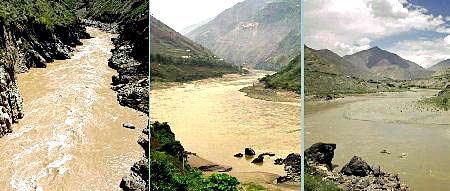Three Parallel Rivers of Yunnan
In the high mountains of southwest China's Yunnan Province, three rivers – the Jinsha, Nujiang and Lancang – all originated from the Qinghai-Tibet Plateau, run roughly parallel, north to south for some 170 km. As the crow flies, the distance between the Jinsha and Lancang rivers is 66 km while that between the Lancang and Nujiang rivers is less than 19 km.
The Three Parallel Rivers site covers land of some 1.7 million hectares. With it come nine nature reserves and 10 scenic spots variously belonging to Lijiang City, Diqing Tibetan Autonomous Prefecture and the Nujiang Lisu Autonomous Prefecture. Located where the three geological regions of East Asia, South Asia and Qinghai-Tibet Plateau meet, it is representative of rare alpine landforms and their evolution, and one of the richest biodiversity areas in the world.
 Sanjiang is a
veritable museum displaying the geological history of the last
40-50 million years associated with the collision of the Indian and
Eurasian Plate and the lifting of the Himalaya Range and Tibetan
Plateau.
Sanjiang is a
veritable museum displaying the geological history of the last
40-50 million years associated with the collision of the Indian and
Eurasian Plate and the lifting of the Himalaya Range and Tibetan
Plateau.
Every kind of landscape to be found in the northern Hemisphere other than desert and ocean can be found here including magnificent snow-capped mountains and glaciers, precipitous Danxia cliffs and wonderful Karst formations.
The region has 118 snow-capped mountains over 5,000 meters above sea level, varying widely in form. With them come many hectares of untouched forest and several hundred glacial lakes.
 Highest among them
at 6,740 meters is the snow-capped Meili Mountain with its
10,000-year-old glaciers. Crystal-clear and sparkling, the ice
makes its way very slowly from high on the peak down to the
Mingyongcun Forest at 2,700 meters. It is considered to be the
world's finest monsoon glacier and remarkable for its descent to
such a low altitude. For thousands of years, Tibetan people have
regarded the Meili as a holy mountain. To this day they respect the
need to obtain permission before going on the mountain.
Highest among them
at 6,740 meters is the snow-capped Meili Mountain with its
10,000-year-old glaciers. Crystal-clear and sparkling, the ice
makes its way very slowly from high on the peak down to the
Mingyongcun Forest at 2,700 meters. It is considered to be the
world's finest monsoon glacier and remarkable for its descent to
such a low altitude. For thousands of years, Tibetan people have
regarded the Meili as a holy mountain. To this day they respect the
need to obtain permission before going on the mountain.
 The Danxia
landforms in the Laojun Mountains in the Lijiang Area, picturesque
in their forest setting, are both the biggest and the best-formed
examples of this geomorphology in China. In places, the red cliffs
have weathered away to leave formations said to look like
tortoises. On the aptly named thousand tortoise mountain, one can
imagine at first a single large tortoise and then on closer
inspection see it to be made up of the regular ranks of thousands
of small tortoises.
The Danxia
landforms in the Laojun Mountains in the Lijiang Area, picturesque
in their forest setting, are both the biggest and the best-formed
examples of this geomorphology in China. In places, the red cliffs
have weathered away to leave formations said to look like
tortoises. On the aptly named thousand tortoise mountain, one can
imagine at first a single large tortoise and then on closer
inspection see it to be made up of the regular ranks of thousands
of small tortoises.
First among China's 17 key bio-diversity areas, the site with its precious gene bank, has been acclaimed as being of world class importance. Though accounting for less than 0.4 percent of the area of the country, the region plays host to more than 20 percent of the country's most important plants and 25 percent of its animal species. Today the region is home to 77 animals under state-level protection including the Yunnan golden monkey, antelope, snow leopard, Bengali tiger and black-necked crane. It has 34 kinds of plants under state-level protection including the China fir (Cunninghamia lanceolata), the spinulose tree fern (Cyathea spinulosa) and the Chinese yew (Taxus chinensis).
 Every year when
spring comes again, the region becomes a sea of flowers. There are
200 kinds of azaleas, nearly 100 kinds of gentian (Gentiana
scabra), and primroses, Scrophylariaceae,
Cypripedium and lilies.
Every year when
spring comes again, the region becomes a sea of flowers. There are
200 kinds of azaleas, nearly 100 kinds of gentian (Gentiana
scabra), and primroses, Scrophylariaceae,
Cypripedium and lilies.
In the meantime, the region is inhabited by 16 ethnic groups, one of the few areas in the world where different kinds of people, language, religious belief and customs live in harmony.
In 1985, a UNESCO official discovered this world wonder from among satellite scanning images. In 1988, the Three Parallel Rivers area was designated as a state-level scenic attraction with the approval of the State Council.
On July 2, 2003, the site was inscribed on the World Heritage List as a natural property at the 27th session of the UNESCO's World Heritage Committee.

Three Parallel Rivers Scenic Area Management Office, Yunnan Provicial Government
Tel: 86-871-4113446
(China.org.cn September 12, 2003)
 0
0 






